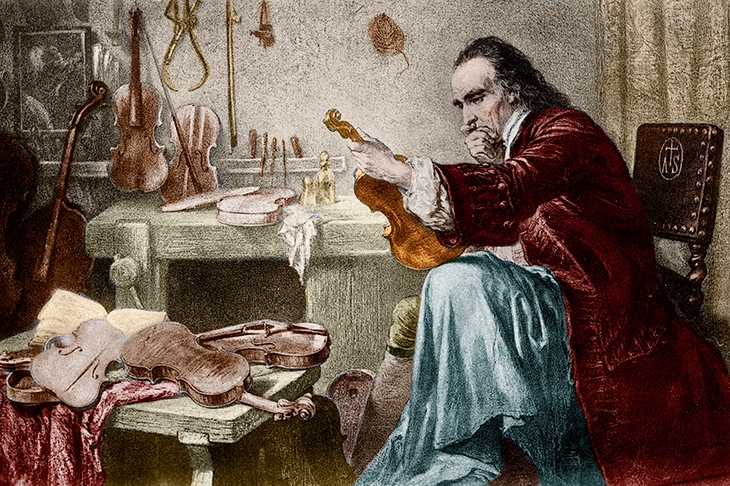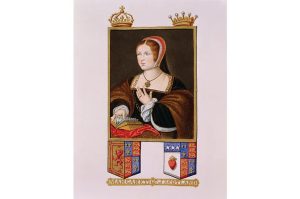An extraordinary omission from Neil MacGregor’s A History of the World in 100 Objects is the lyre, the instrument closest to Homer’s heart. Without it, the evolution of bowed stringed instruments — rebec, lira da braccio, violetta — would not have taken place. Ipso facto, there would be no violin, nor its larger siblings; no chamber music, no orchestra, no Hot Club de France. In such a parallel world, Helena Attlee would be much time-richer, given that she has spent more than four years researching the provenance of a single violin.
At a Klezmer performance in a small Welsh town the author is moved by the joyous but wistful celebratory music of the Ashkenazi Jews: ‘I heard the violin speak for the first time, with a voice powerful enough to open pores and unbuckle joints.’ In conversation with Greg, the violinist, she learns that the instrument is valued as worthless, lacking a luthier’s label. It is sweet-sounding, but with no pedigree. He had bought it from Lev, after borrowing it years earlier. The latter, a Russian émigré settled in Scotland, had bought it in turn from an old Roma violinist in Russia in about 1980. But how did it end up there? Who else had left their ‘intimate residue of sweat’ and musical DNA in it? Who made it? These questions drive Attlee first to Cremona, home of the dynasties of the great 17th- and 18th-century luthiers and their progeny, the modern violin.
The death of the pre-eminent Nicolò Amati in 1684 brought Antonio Stradivari to the fore as the luthier per eccellenza in Lombardy and far beyond. He strove to meet the demands of the best players and composers (Albinoni, Corelli, Torelli), all of whom wanted instruments that could stand out against the volume of a full orchestra. Top players moved like attachés between city states, courts, palaces and wealthy patrons. Similarly, well-endowed churches nurtured music. Together with amber rosaries, beeswax candles and stained-glass windows, violins intensified the experience of religious adoration.
Luthiers made instruments for church string-sections but were forbidden to put their labels inside. Cardinals did not want their musicians and priests selling the violins when their value increased on account of the name inside. But as a consideration to the luthiers their church violins were tax exempt. Could Greg’s violin, Attlee wonders, have been one such instrument, made to the exacting standards of an Old Italian, just without a label: ‘I found myself imagining…’ Perhaps this violin was commissioned by the Ospedale della Pietà in Venice, where the orphans and foundlings studied music to play under Vivaldi’s baton.
So great was Stradivari’s domination that less able competitors were driven out of Cremona; after his death in 1737, the city was no longer the center of lutherie as under Amati. A little under 200 years later, the Fascist government was enthusiastically preparing the ground for the bicentennial; and prepare it they did — by demolishing the houses where Stradivari and Guarneri had lived and worked, and flattening the area to design and build on stripped classical lines. Yet the commemoration was an international success, and reconfirmed the value of soft power projected by the sweet violin.
By this time Jewish musicians had been sacked from orchestras by the Nazis, and misappropriated violins had been passed on to German children. Occupied cities would be pillaged, and many more violins would fall into the invaders’ hands. Later, a unit of trophy-hunters would follow the Red Army westwards to remove items of value from German homes, museums and theaters. Thus, many instruments were twice looted. Might Greg’s violin be one of them? A trip to Rostov-on-Don, with Lev’s wife as fixer and translator, adds a little faded color but nothing of substance to the author’s quest. And how could it really, nearly 40 years after the violin’s purchase from a stranger in a rundown market?
Back home again, Attlee hears bad news: something calamitous, but not unexpected, has happened to the violin. Greg’s luthier, although disinclined to, agrees to repair it for the last time. A premature death follows — and the funeral has a serendipitous outcome. A dendrochronologist and a violin dealer solve the provenance poser. Who can say, though, if this old fiddle still has a good tune to play on it?
The author knows Italy well. Her love and unbounded enthusiasm for the country shine through the pages. She writes with zest about her sleuthing odyssey, her investigations into the art of lutherie and the dynasties dedicated to the crafting of these delightful objects. Whether it be a distant family history, the timber forests of the Dolomites or a momentary encounter, Attlee captures it in firm, fresh prose.
This article was originally published in The Spectator’s UK magazine. Subscribe to the World edition here.





















